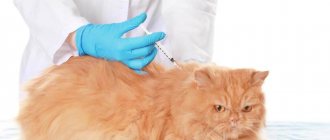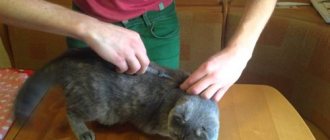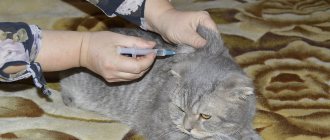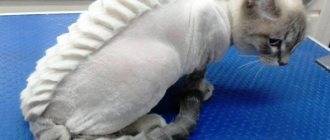Home » Useful Information
A healthy and active pet always makes its owner happy. But unfortunately, the disease can overtake anyone: not only a “walking” pet, but also an absolutely domestic furry one. The specialist makes a diagnosis and determines the course of treatment. Injections are often prescribed. Of course, you can visit the clinic every day, but when injections need to be given not once, but twice, or even three times a day, it is easier to learn how to carry out these manipulations yourself.
- 2 In what places is a cat given an injection?
2.1 Rules for the manipulation
- 4.1 Intramuscular injection into the thigh
4.1.1 Video: how to give an intramuscular injection to a cat
- 4.2.1 Video: how to inject a cat at the withers
Preparation for the procedure
Do not feed your cat various medications or give injections without consulting a doctor: this can harm your pet’s health. If the veterinarian has prescribed injections, then follow the dosage and follow all instructions.
If you are even a little worried before the procedure, then you will have to relax and calm down, because pets perfectly understand your mood and emotions.
Before you give your furry an injection, you need to prepare:
- Use only sterile disposable syringes. For a dose of less than 1 ml, it is better to take insulin with a short needle.
- Always check the expiration date of the medicine, study the instructions thoroughly, and especially the section indicating the exact dosage.
- First, wash your hands with soap and dry thoroughly with a clean, dry towel.
- Warm the ampoule with your hands to body temperature.
- Take a paper napkin, fold it several times and wrap it around the top of the ampoule.
- Break the ampoule in the direction opposite to the cut.
- Draw the medicine into the syringe; this should be done 5 minutes before the injection.
- Place the injection vertically, tap a little with your nail (so that air bubbles come off the walls) and release the air with a small amount of the drug. Now the injection is completely ready, all that remains is to prepare the cat for the upcoming injection.
Possible difficulties
For a non-specialist, giving an intramuscular injection can be difficult, especially for the first time. It must be remembered that anxiety is transmitted to the pet, so it is very important to remain calm. The injection is necessary in order to help the animal, so there is absolutely no need to feel guilty.
If after an intramuscular injection blood appears on the surface of the skin or fur, this is considered normal. But if the bleeding does not stop, then you need to apply something cool to the manipulation site for 15-20 minutes. It is important not to overdo it and not to overcool the injection site.
Lameness may persist for some time from the injection of painful drugs, but if the limb hangs lifelessly and has lost mobility, this is a reason to seek advice from a specialist.
Subcutaneous injection
How to give a subcutaneous injection to a cat, follow all steps in order:
- Place your pet comfortably, for example, on your lap or on the sofa. Examine the withers, it is important that there are no inflammations, wounds or diaper rash on the skin.
- Pull the withers up a little and form a fold with your hand.
- The needle should be held parallel to the back and carefully but firmly insert the syringe into the fold. If you use an “insulin syringe,” then deepen the entire needle; with another type of syringe, only 0.5-0.7 cm.
- If, after piercing the skin, you feel that the needle will fall inward, this is a notification that the needle has successfully pierced. Administer the medicinal solution. Upon completion of the administration of the medicine, remove the needle along the same trajectory.
Where is the withers located in cats?
Let's figure out where to look for a cat's withers. The withers are the area where the back and neck connect. Most of it is located immediately above the shoulder blades; the skin in this place easily folds, creating a “pocket” where the injection can be made.
Why are injections given at the withers?
To quickly administer the drug and reduce pain, an injection is given to the cat at the withers. The area above the shoulder blades is insensitive, and when injected under the skin, the pet experiences virtually no uncomfortable sensations. The loose structure of the subcutaneous tissue, if necessary, allows the introduction of large volumes of solutions, thus conducting infusion therapy (droppers).
Other sites for hypodermic injections in cats
In addition to the withers, you can choose other places for subcutaneous injections. For example, the groin fold or the front of the thigh. The loose structure of the skin in these places makes the injection almost painless. Some drugs are even recommended to be placed specifically in the inguinal fold. It is recommended to place vaccines in the area of the inguinal fold, because this makes it easier to remove post-vaccination sarcoma if a complication occurs.
Intramuscular injection
How to inject a cat in the thigh:
- Lay the cat on its side, it is best to have someone from your family or friends help you.
- Feel the bone so as not to hit it with a needle.
- There is no need to somehow compress or stretch the corner location.
- The needle should be inserted into the central part of the thigh 1 cm at an angle of 45°; remove the needle in the same projection so as not to cause pain to the cat.
Useful lifehack! If there is no one at home and you do not know how to give a cat an intramuscular injection, then you can calm the cat with a clothespin. Secure it to the withers, the cat will think that someone is holding it, and therefore will not kick and try to escape. They have developed this reflex since childhood, when their mother drags them from place to place.
General recommendations
Do not panic. The more afraid you are, the more unnecessary movements and sounds you will make that can frighten the cat. Your pet may sense something is wrong and begin to panic before you even begin to notice.
In order not to be distracted by searching, prepare everything you need in advance and put it within reach.
Carry out the procedures at rest. For example, when the cat has just woken up or started its normal daily activities. Do not perform the procedure when she is angry, playful, or completely in the mood for contact with you.
Calm your pet and talk to him throughout all manipulations.
If at the time of injection you see that the fur has become wet, then you have pierced the skin right through and the solution has begun to flow out. It is worth stopping the procedure.
Rate of drug administration
It depends on the volume of the medicine, as well as on its thickness. Aqueous solutions are injected at an average rate of 1 ml per 1 second, and oily or viscous solutions - the same volume in 5-7 seconds.
If all the instructions presented are difficult for you to perceive in text form, then you can watch a video on how to give an injection to a cat.
The appearance of abscesses
Swelling and ulcers after injection can only appear if you performed this procedure incorrectly. A dangerous microorganism or bacterium penetrates into a small wound, resulting in an infection, accompanied in most cases by tissue inflammation.
The swelling may go away on its own after some time. If this does not happen, then an abscess forms, they are already removed through surgery, after the operation the veterinarian prescribes a course of anti-inflammatory drugs.
Lameness
Limping on the hind leg is common after injection. Most often, this happens after painful injections - antibiotics or thick, oily medications.
Veterinarians assure that there is no need to worry about lameness - most often, pets begin to run on the 2nd day.
But if your Murzik has been limping for 3-4 days, then you need to take action, since this is not a normal phenomenon. In this case, you need to show the cat to the doctor as soon as possible, and he will determine the cause of the lameness and prescribe the appropriate course of treatment.
What complications may there be?
The introduction of medicinal solutions, regardless of the location, injures the surrounding tissues. Complications can arise not only when the procedure is carried out ineptly, but also from an experienced specialist. The most common negative consequences of injections are:
- hematomas – formed due to damage to a blood vessel by a needle and penetration of blood into neighboring tissues; they do not require special treatment and go away on their own;
- blood protruding after removing the needle - just as in the previous case, serves as a sign of damage to the blood vessel; to stop the bleeding, it is enough to apply cold to the wound;
- bump, compaction, swelling at the injection site - can have several reasons, for example: too rapid administration of the medicine, infection entering the wound, individual tissue reaction, and others; if the bump does not go away for a long time, and the cat’s well-being worsens, you need to show your pet to a specialist;
- lameness - can be a consequence of the injection itself, as damage to soft tissues, for example, with severe pain from the solution, or as a result of the needle getting into the sciatic nerve; in the latter case (if the damage persists for longer than 2-3 days and the paw remains motionless), you need to visit a veterinarian;
- deviations in behavior are a normal reaction of an animal that goes away on its own over time; the cat may panic, avoid touching, flinch, and so on;
- an increase in body temperature - more often occurs as a reaction to the injected solution, a manifestation of an allergy, and also if sterility was not maintained during the procedure and an infection got into the wound.
Additional symptoms that you need to pay attention to and consult a doctor: pus from the skin puncture site, painful lumps, refusal to eat, loss of activity, apathy for more than 3 days after the injection.
Nervous behavior
It happens that after an injection and similar medical procedures, the cat becomes nervous, does not touch itself, and hides from you at every opportunity. In veterinary practice, this phenomenon is called a psychological attack.
This causes changes in the functioning of the nervous system, resulting in fear of injections, stress when visiting a veterinary clinic or even when seeing a person in a medical uniform.
- In this situation, there is nothing you can do, you can only wait.
- After some time, your pet will return to its original state.
- You can try to cope with this with the help of treats, preferably harmless (fish treats, pieces of dehydrated meat, etc.)
Young cats can be entertained with games or walks to distract them from the psychological attack, unless treatment involves reducing activity.
Heat
A slight increase in the animal’s body temperature after injection is considered an adequate reaction of the body.
- But if the high temperature persists for more than 3 days, then you need to immediately go to the veterinary clinic.
- Typically, this complication is associated with an allergy to a drug or the development of an inflammatory process.
We hope that this material was useful to you, and now you can give your cat an injection yourself. Good luck!
Calm, just calm!
Before the procedure, the animal should be calmed, because the muscle should be relaxed. To do this, you should take your pet in your arms and bring it into the appropriate state with affection. The area before the injection does not need to be treated with alcohol, but it is advisable to do so after the injection. At the same time, the surface of the skin itself should be healthy, without wounds.
It’s not just the pet that needs preparation—cats sense their owner’s mood very well. For this reason, if fear or severe anxiety has crept into your soul, you should not approach an animal with such a “load.” To begin with, you should calm down and start preparing for the procedure, and only after that go to catch your pet.
How to give an injection to a cat? It is impossible to prepare the pet itself for the procedure, so it is important to create comfortable conditions so that the injection does not result in severe stress. The best option is to stay alone with the cat, but often the injection is not always successful. Therefore, you have to hire an assistant to hold the animal.











